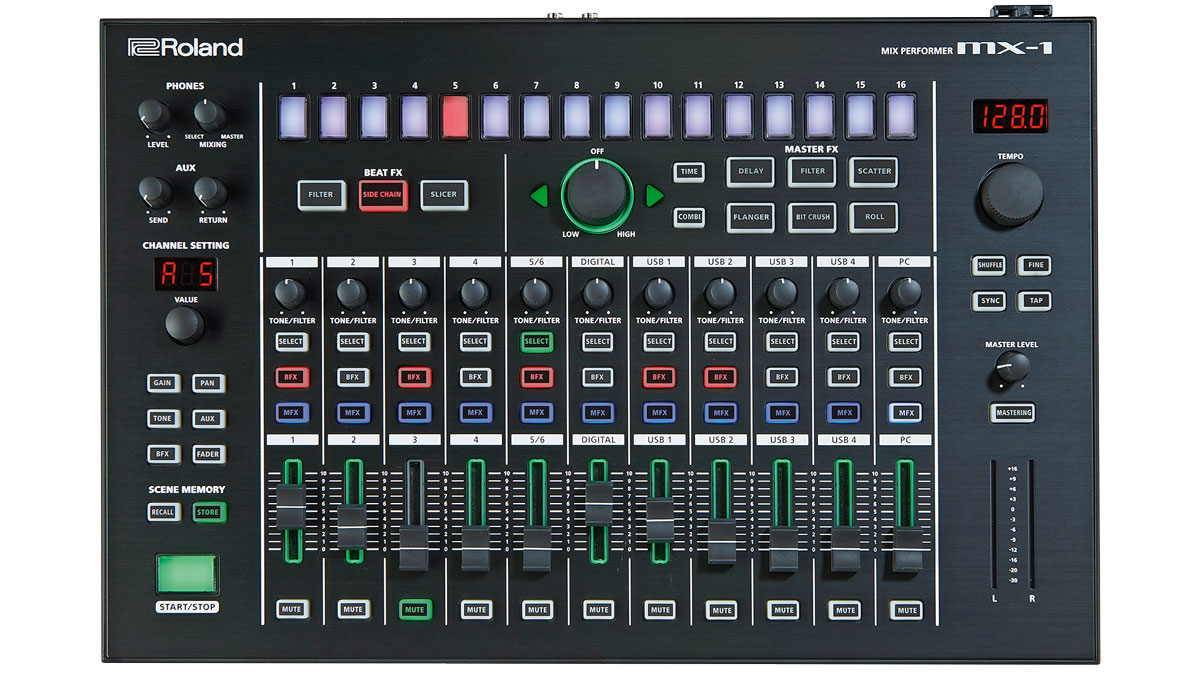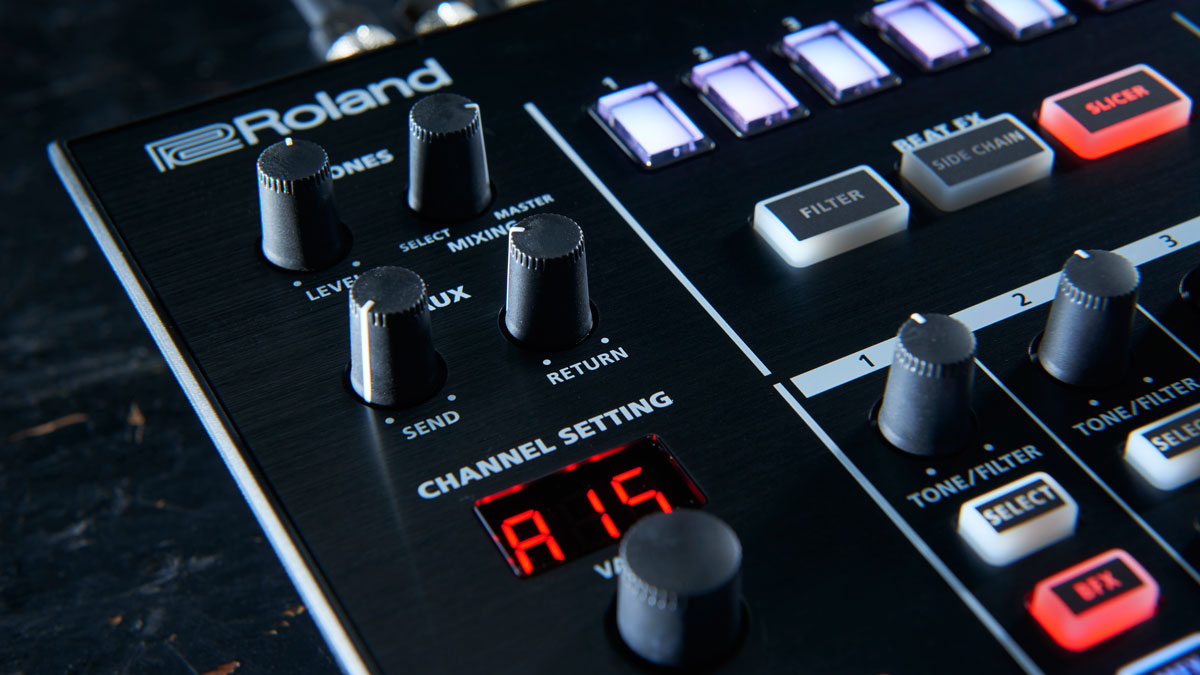MusicRadar Verdict
Looking for something flexible to build a live and/or studio set-up around? This is certainly an option worth keeping in mind.
Pros
- +
Good mix of analogue and digital connectivity. Range of standalone, interface and controller modes offers a lot of flexibility.
Cons
- -
Only offers a single stereo channel for the Aira TR-8. EQ capabilities are somewhat limited. Effects can be a little in-your-face in their default modes.
MusicRadar's got your back

Roland Aira MX-1 Mix Performer

Roland Aira MX-1 Mix Performer

Roland Aira MX-1 Mix Performer
Categorised by Roland, slightly awkwardly, as a Mix Performer, the MX-1 is part mixer, part multi-effect, part interface, and quite unlike anything else on the market now.
Design-wise, it bears a close resemblance to the Aira TR-8, housed in a plastic chassis of the same dimensions and sporting a similar - if slightly rearranged - selection of faders, knobs and sequencer buttons. It has a similar black/green colour scheme too, although doing away with the green trim around the edge, which leaves the MX-1 looking ever so slightly smarter than its borderline-garish Aira counterparts.
At its most basic level the MX-1 is an 18-channel mixer, which can operate either as a standalone device or as an interface for a Mac or PC. Connection wise, the MX-1 features two pairs of mono 1⁄4-inch jack inputs, along with an additional stereo 1⁄4-inch jack in.
The rest of the input channels come from a quartet of 'Aira Link' USB ports, which can send/receive audio and MIDI from a selection of Roland products, and a digital coaxial in/out port.
Outputs, meanwhile, consist of a pair of mono jacks for the main out, along with a separate headphone jack that outputs a monitor signal.
There's also a phono send and return. The back panel is rounded off by a pair of standard MIDI in/out connectors and a main USB port for connection to the host computer.
Those inputs are controlled via 11 mixer channels on the front panel, each comprised of a fader, a trio of effect select buttons and a single Tone/Filter dial. The first two pairs of analogue inputs get a fader for each mono channel, which can be linked into pairs controlled by channels one and three. Inputs five and six, meanwhile, share a single mixer channel.
Want all the hottest music and gear news, reviews, deals, features and more, direct to your inbox? Sign up here.
The Beat FX can be scaled back from obnoxious Vegas- style pumping into subtle, polyrhythmic territory.
The next four channels correspond to the four Aira Link ports, although when no eternal gear is connected to the USB input this can be assigned to mix audio channels from a DAW connected to the primary USB port.
Finally, the last channel controls the main output signal from the computer.
As an interface, those four Aira Link ports make the MX-1 an appealing prospect for owners of other Aira products. Each of the flagship instruments in the Aira range - the TR-8 drum machine, TB-3 bass synth and System-1 synth - can transmit audio to a host computer via USB, but doing so can be a little unwieldy.
To use them alongside an existing interface, you need to create an aggregate interface but, since the Airas have a fixed sample rate of 96k, they can be inflexible on that front. So, being able to hook multiple Aira units up to a single hub - which also provides a decent number of analogue ins for recording - is considerably more convenient. The MX-1 has an adjustable sample rate too.
Each of the Aira Link inputs provides a stereo channel of audio into the MX-1, with its own fader on the front panel.
While it's great being able to feed multiple USB inputs into one unit, we were disappointed to discover that the TR-8 is limited to a single stereo output when connected via Aira link. Used standalone, the drum machine offers 14 channels of audio over USB (ie one for each drum), along with two sets of analogue outs - a main output and an additional pair of assignable jacks.
Particularly given the MX-1's focus on performance effects, having just the one stereo output for the whole drum machine feels a bit limiting should you wish to, say, use a stereo delay without affecting the kick elements, which doesn't work so well in stereo.
It's not the end of the world, but it just seems like Roland has missed a trick by giving the TR-8 less, rather than more output options when used with the MX-1, particularly since the mixer seems to offer so much in the way of flexibility in other areas.
On the plus side, recent updates have added an assortment of extra Roland products to the list of gear compatible with the Aira Link ports, including the JD-XA, JD-Xi, Jupiter-50/80, FA-06/08 and the new Juno-DS, which broadens its potential appeal.
Full effect
The MX-1's mixer and interface capabilities are, however, only half the story. The unit also offers an assortment of effects capabilities, at both per-channel and master levels. Each channel can be assigned one of three Beat FX: Filter, Slicer and Sidechain, each with five selectable variations.
These three effect types all offer variations on a rhythmic 'ducking' effect; Filter via a low-pass filter, Slicer an abrupt gating effect, and Sidechain mimicking the ubiquitous 'pumping' sound associated with heavy-handed compression. Each effect is controlled via the 16-step sequencer, which is used to punch in the effect on a per step basis (it's worth noting that Sidechain is actually more of a pseudo-sidechain, controlled by the sequencer rather than routed audio input).
In their default state, each effect is set to maximum and the results are somewhat in-your-face. Fortunately, it's possible to adjust both the intensity and the length of each channel's effect. Used with a slightly lighter touch, the MX-1's Beat FX can easily be scaled back from obnoxious Vegas-style pumping into subtle, polyrhythmic territory.
Each channel also benefits from a Tone/Filter rotary. These can be assigned an EQ or filter effect from a range of ten options, which cover bases from DJ-style bi-directional filtering to low/high frequency boosts. These offer a decent range of tone-shaping options, although anybody used to performing with DJ gear or more traditional 'live' mixers, will likely miss having a proper (at least) three-band EQ.
The MX-1's Master FX section, meanwhile, offers six effect types: Delay, Filter, Flanger, Bit Crush, Roll (a beat repeat effect) and Scatter (the rhythmic glitch effect found across much of the Aira line).
Again, each effect offers an assortment of variations, with eight types of each on offer (it's worth noting that one of the Delay's alternative modes is a reverb). A central bi-directional rotary is used to dial in the intensity of each effect, while a combination of the Time button and Tempo dial are used to edit the length.
The Master FX section also offers a Combi mode, which lets users assign different effects to each step across the sequencer, with unique, if a little full-on, results.
The final piece of the MX-1's effects puzzle comes from the auxiliary send/return, connected via two phono ports on the rear of the unit and dialled in for each channel via the Channel Settings panel. Here it's possible to edit the Gain, Pan and Fader curve of each channel too.
Particularly for owners of compatible Roland gear, the MX-1's combination of analogue and digital inputs, along with its ability to work with or without a computer, makes it a very interesting addition to the interface/mixer market.
On the effects front, while its pumping Beat FX might seem a bit garish on the surface, and a little too entrenched in a certain style of in-your-face festival EDM, there's a deceptive amount of depth on offer. It's fairly easy to rein in the sound to create something more nuanced.
It's not perfect though; as mentioned, the lack of individual outputs for the TR-8 is a disappointment, and the single Tone/ Filter knob is no match for a proper EQ section. Neither of these are things that can't be worked around, however, and the fact remains that the MX-1 is innovative and offers a good range of practical features.
It won't suit everyone, but for a certain demographic of laptop-based producers keen to incorporate some hardware into their workflow, the MX-1 will prove very appealing.
I'm the Managing Editor of Music Technology at MusicRadar and former Editor-in-Chief of Future Music, Computer Music and Electronic Musician. I've been messing around with music tech in various forms for over two decades. I've also spent the last 10 years forgetting how to play guitar. Find me in the chillout room at raves complaining that it's past my bedtime.